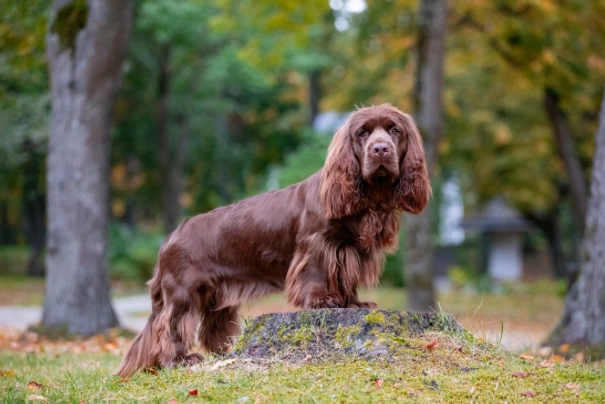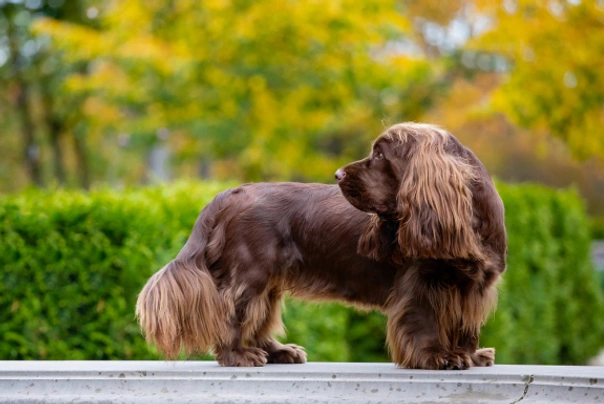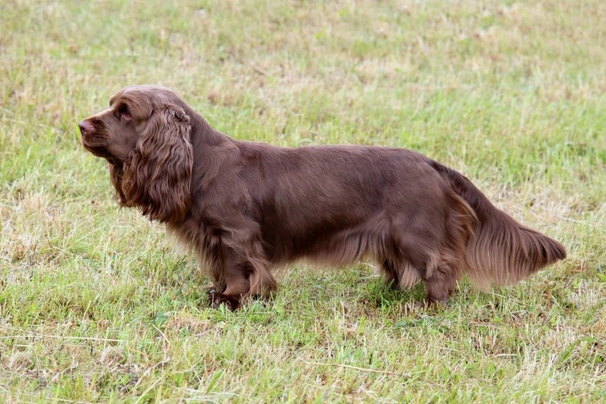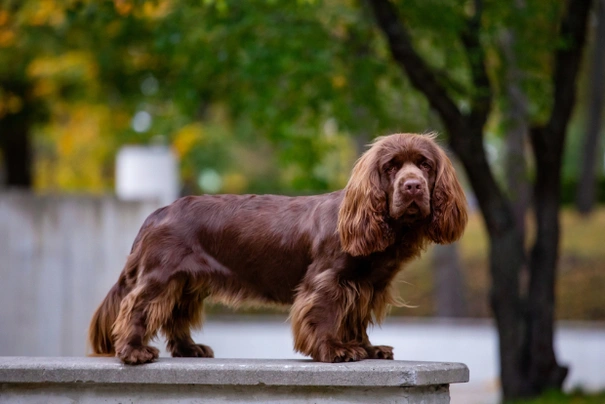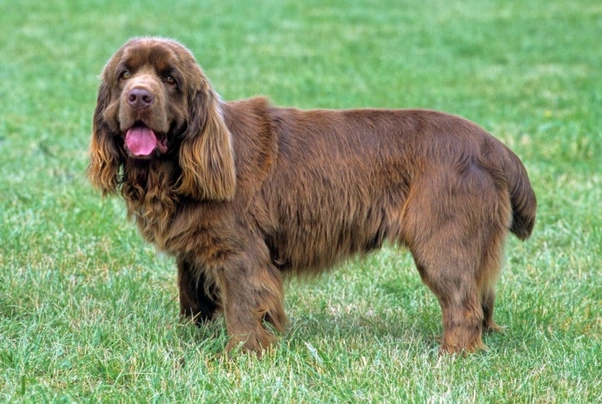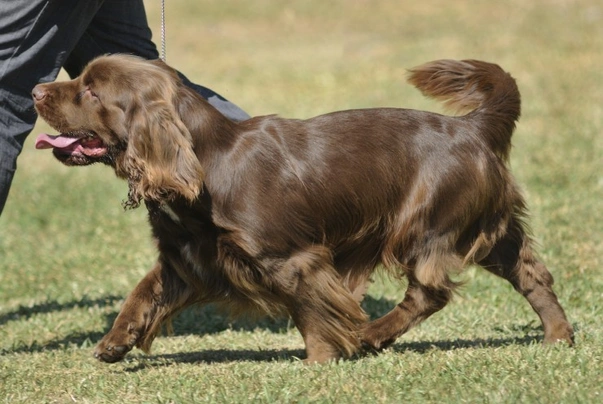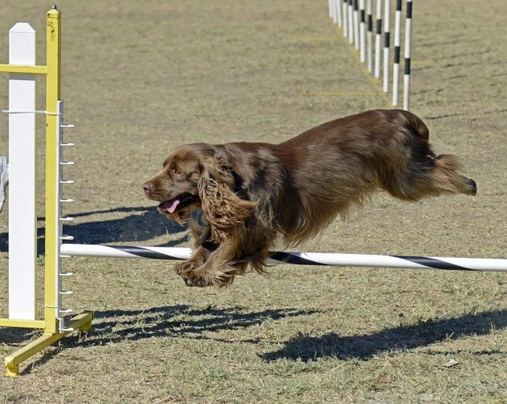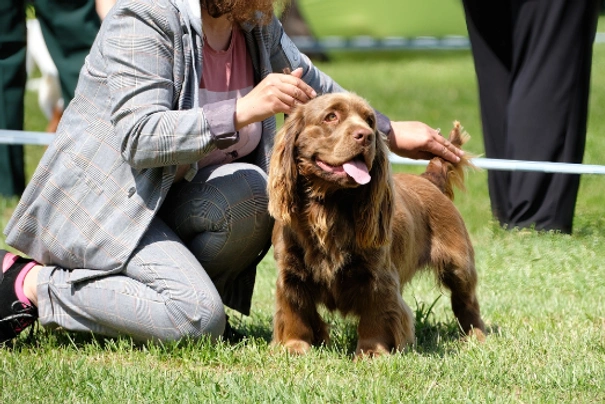Sussex Spaniel
Pros
Cons
Introduction of the Sussex Spaniel
The Sussex Spaniel is one of the UK's vulnerable native breeds with only very few pedigree puppies being registered with The Kennel Club every year. They are quite heavily built dogs compared to other spaniels and boast a profuse golden/liver coat. They have a unique look with wider heads than which paired to their wrinkled brow adds to their overall charming appearance.
Although not as popular as other spaniel breeds they are highly rated as working gundogs in the field and are very popular in the showring. With this said the Sussex is known to be a kind natured dog and one that makes a great family pet being just as happy in a home environment as there are working in the field. However anyone wanting to share a home with a Sussex Spaniel would need to register their interest with breeders for the pleasure of doing so.
History of the Sussex Spaniel
Sussex Spaniels are one of the oldest native breeds in the UK having been around since the early 1800's. One of the breed's main enthusiasts was a landowner by the name of Mr. Augustus Elliott Fuller who kept Sussex Spaniels and others at his kennels on his large estate that was situated in the county of Sussex. He bred spaniels over a time span of 50 years as working dogs with great success.
Although there were other Sussex Spaniels around at the time breed numbers dropped by the end of World War II and by 1945 there were only 7 known to be in existence. Fortunately thanks to the efforts and hard work of breed enthusiasts including one lady in particular by the name of Mrs. Freer the Sussex Spaniel was saved from extinction and the Sussex Spaniel Association was later formed in 1924. Slowly through careful and selective breeding Sussex Spaniel numbers started to rise over the ensuing decades albeit it slowly.
Today their numbers remain quite low with only around 60 to 100 pedigree puppies being bred and registered with The Kennel Club every year. As such these charming spaniels have been placed on the UK's native vulnerable breed list and were only recognised as a unique breed in the own right by The Kennel Club in 2004 although as previously mentioned these charming spaniels have been placed on the KC’s list of native vulnerable breeds.
Interesting facts about the breed
- Is the Sussex Spaniel a vulnerable breed? Yes they are listed as a native vulnerable breed with the Kennel Club with few puppies being registered every year
- The Sussex Spaniel is a uniquely British breed
- Traditionally a Sussex Spaniel’s tail was always docked but since the law banning the procedure came into effect in 2007 tail docking is now illegal with the exception being for some working breeds and if a dog suffers from some sort of health issue that requires their tails to be docked. The procedure must be agreed and authorised before being performed by a qualified vet failure to have the correct paperwork would result in heavy fines
Appearance of the Sussex Spaniel
Height at the withers: Males 38 - 41 cm Females 38 - 41 cm
Average weight: Males 16 - 20 kg Females 16 - 20 kg
Sussex Spaniels are smaller lower to the ground and they have larger heads than other spaniel breeds which gives them a very unique look all of their own. They are robust strongly built dogs and when they are on the move they have a very distinct roll about them. Their heads are wide with dogs having a rather distinct curve between their ears and an indentation in the middle. They have a very pronounced stop and noticeable occiput which adds to the overall balanced look of a dog's head.
Their brows are furrowed giving the impression that a Sussex Spaniel is always frowning and they have well developed nostrils with nice liver coloured noses. Their eyes are a nice hazel colour being quite large and having a gentle expression in them. Ears are quite large and lobular being set moderately low on a dog's head lying close to their faces. The Sussex Spaniel has a strong jaw with a perfect scissor bite where their upper teeth neatly overlap their lower ones.
Their necks are strong long with a hint of an arch and dogs have a nice frill around their necks. They have sloping shoulders and strong powerful well-muscled short front legs showing a good amount of bone. Chests are well developed and deep with dogs having nicely developed and muscular backs and loins having a good depth and width to them. Their back ribs are deep adding to the powerful appearance of the Sussex Spaniel's body. Back legs are strong powerful and well boned.
Their feet are well padded and round in shape with a good amount of feathering in between their toes. Tails are set low and are moderately long which dogs carry level to their backs but never above. Their tails are thickest at the root but taper to the tip and are nicely feathered. When excited or alert a Sussex Spaniels wags their tail in a very lively manner which is one of their endearing traits.
When it comes to their coat the Sussex Spaniel has a profuse flat top coat with a good amount of softer denser undercoat. Their ears are covered with wavy and much softer hair with their forequarters as well as their hindquarters being moderately feathered too. The only accepted breed colour for Kennel Club registration is as follows:
- Golden liver
It is worth noting that the accepted breed colours for Kennel Club registration can differ from those set out in the breed standard which are as follows:
- Rich golden liver with hair being shaded to golden at the tips
Under the Kennel Club breed standard dark liver or puce colour coats are highly undesirable
Gait/movement
When a Sussex Spaniel moves they do so with a distinct roll both in their forequarters and hindquarters.
Faults
The Kennel Club frowns on any exaggerations or departures from the breed standard and would judge the faults on how much they affect a dog's overall health and wellbeing as well as their ability to perform.
Males should have both testicles fully descended into their scrotums and it is worth noting that a dog can be a little lighter or heavier as well as slightly taller or shorter than set out in the Kennel Club breed standard which is only given as a guideline.
Temperament of the Sussex Spaniel
Unlike other gundogs the Sussex Spaniel likes to let an owner know when they have found something or when they are excited about anything. As such they are known to bark which is something deeply embedded in their working psyche. They have a very calm and kind disposition and like to do things at their own slower pace which is another unusual trait for a spaniel. They love being part of a family and are just as happy in a home environment as they are working in the field which is one of the reasons why they make such wonderful family pets and companions.
They are intelligent dogs and as such they need to be given the right amount of mental stimulation or boredom would quickly set in which could lead to a dog developing some unwanted behavioural issues. Sussex Spaniels thrive on having people around them and are never happy when left on their own for any great length of time. As such they are a great choice for people who live in the country and in a household where at least one person usually stays at home when everyone else is out.
With this said they are a great choice for first time owners thanks to their kind placid laid-back natures and the fact they are always willing and eager to please. But these spaniels are high maintenance on the exercise front and need to be given lots of "off the lead" time to be truly happy well-rounded characters.
It's important for Sussex Spaniel puppies to be well socialised from a young enough age so they grow up to be more confident mature dogs. Their socialisation has to include introducing them to lots of new people situations noises other animals and dogs once they have been fully vaccinated. Their training also has to begin when they are still young in order to gently curb their rather strong hunting instinct. They can be a little wilful at times but with patience and understanding this can easily be overcome.
In the right environment and with the correct amount of early socialisation and training a Sussex Spaniel is a real pleasure to have around and they are more than happy to curl up on a sofa at the end of the day with their owners. Because they boast such kind natures Sussex Spaniels are often seen working as PAT therapy dogs in schools hospices and hospitals.
Are they a good choice for first time owners?
Sussex Spaniels are a good choice for first time dog owners because they are so amenable and people-oriented loving nothing more than to please and to entertain their families. When they grow up with children in the home they get on well together. However as with other breeds care should be taken when puppies and dogs are around very young children just to be on the safe side.
What about prey drive?
Although social by nature Sussex Spaniels were bred to hunt and therefore they have a high prey drive and will happily chase any animals that try to run away or that they spot in the distance. As such care should be taken as to where and when a dog can run off the lead more especially if there is wildlife or livestock around. The good news is that a well -trained Sussex would obey a recall command and would stay at heel when asked to.
What about playfulness?
Sussex Spaniels have a very playful side to their natures and love to entertain and be entertained quickly learning how to please an owner and how to get their own way. They do well at obedience and enjoy the one to one attention they are given when being trained or taking part in competitions.
What about adaptability?
Although Sussex Spaniels are highly adaptable dogs being just as happy working in the field as they are in a home environment they are better suited to households with large secure back gardens a dog can safely roam in whenever possible to really let off steam.
What about separation anxiety?
Sussex Spaniels form strong ties with their families and dogs are never very happy when they find themselves left on their own for longer periods of time. However they are not known to suffer from separation anxiety providing they are not left for too long which could see any dog develop some unwanted and destructive behaviours around the home as a way of relieving the stress they are feeling.
What about excessive barking?
Some Sussex Spaniels like the sound of their own voices a little too much which is something that needs to be gently nipped in the bud when a dog is still young being careful not to frighten them. Others will only bark when there are strangers about or when something they don't like is going on in their surroundings. With this said they have a distinct voice and will happily “bay” or howl when left to their own devices for extended periods of time.
Do Sussex Spaniels like water?
Most Sussex Spaniels love swimming and will take to the water whenever they can more especially when the weather is hot. However if anyone who owns a dog that does not like water should never force them to go in because it would just end up scaring them. With this said care should always be taken when walking a Sussex off the lead anywhere near more dangerous watercourses just in case a dog decides to leap in and then needs rescuing because they cannot get out of the water on their own. It is also important to thoroughly dry off a dog’s ears to prevent any ear infections from flaring up.
Are Sussex Spaniels good watchdogs?
Unlike many other spaniels the Sussex is a good watchdog because they are by nature suspicious around strangers and people they don’t already know bearing in mind they are also very protective of their families and property.
Intelligence / Trainability of the Sussex Spaniel
The Sussex Spaniel is known to be a happy cheerful dog but they do have their own special ways about them. This includes doing things at their own pace. As such they are not as fast when it comes to learning new things but with patience and understanding these charming dogs can be taught to behave nicely and to be obedient. It might just take a little longer for the penny to drop than it does with other spaniel breeds.
Like many other dogs the Sussex Spaniel is sensitive by nature and in particular to "voice" commands. As such it would be a mistake to use a raised voice to correct them. This would not achieve positive results and may even end up making a Sussex Spaniel a little on the timid side. They do respond extremely well to positive reinforcement which always brings out the best in these dogs. However it's best to give fewer high value rewards than to give a Sussex Spaniel lots of lower value ones because they are prone to putting on too much weight far too easily which could end up shortening their lives considerably.
Like all puppies Sussex Spaniels are incredibly cute when young and it is all too easy to spoil them when they first arrive in new homes. As soon as a puppy is nicely settled owners must start out as they mean to go on by laying down ground rules and boundaries so that a puppy understands what is expected of them. It helps establish a pecking order and who the alpha dog is in the household. The first commands a puppy should be taught are as follows:
- Come
- Sit
- Stay
- Heel
- Quiet
- Leave it
- Down
- Bed
Children and other
The Sussex Spaniel is a laid-back character and one that enjoys being part of a family and involved in everything that goes on around them. They are known to be particular good around children especially if they have grown up together. However any interaction between younger children or toddlers and a dog should always be supervised by an adult to make sure playtime does not end up getting too boisterous especially when dogs are still going through their puppy stage.
If well socialised from a young enough age they do get on with other dogs although they can be a little "off" with dogs they don't already know. When a Sussex Spaniel grows up with a family cat in a household they usually get on well together but they would not think twice about chasing off any cats they don't know. Care has to be taken when they are around small animals and pets because their prey drive might just get the better of them.
Health of the Sussex Spaniel
The average life expectancy of a Sussex Spaniel is between 14 and 16 years when properly cared for and fed an appropriate good quality diet to suit their ages.
The Sussex Spaniel is known to suffer from a few hereditary health issues which are worth knowing about if you are planning share your home with one of these active and good-looking dogs but on the whole they are a healthy robust breed. The conditions that seem to affect the breed the most include the following:
- Hip dysplasia – dogs should be hip scored through the BVA/KC Hip Dysplasia Scheme
- Phosphofructosekinase Deficiency (PFK) – dogs can be DNA tested
- Pyruvate Dehydrogenase Phosphatase Deficiency (PDP1) – dogs can be DNA tested
- Multi-focal retinal dysplasia (MRD) – dogs should be eye tested under the BVA/KC litter screening scheme
- Congenital deafness – dogs should be BAER tested through the Animal Health Trust (AHT)
- Skin problems – some Sussex are allergic to specific foods which includes beef wheat and chicken
- Ear problems
- Bloat/gastric torsion
It is worth noting that the Kennel Club breed average COI for the Sussex Spaniel currently stands at 20.3%.
What about vaccinations?
Sussex Spaniel puppies would have been given their initial vaccinations before being sold but it is up to their new owners to make sure they have their follow-up shots in a timely manner with the vaccination schedule for puppies being as follows:
- 10 -12 weeks old bearing in mind that a puppy would not have full protection straight away but would be fully protected 2 weeks after they have had their second vaccination
There has been a lot of discussion about the need for dogs to have boosters. As such it's best to talk to a vet before making a final decision on whether a dog should continue to have annual vaccinations which are known as boosters.
What about spaying and neutering?
A lot of vets these days recommend waiting until dogs are slightly older before spaying and neutering them which means they are more mature before undergoing the procedures. As such they advise neutering males and spaying females when they are between the ages of 6 to 9 months old and sometimes even when a dog is 12 months old.
Other vets recommend spaying and neutering dogs when they are 6 months old but never any earlier unless for medical reasons. With this said many breeds are different and it is always advisable to discuss things with a vet and then follow their advice on when a dog should be spayed or neutered.
What about obesity problems?
As with other breeds some Sussex Spaniels gain weight after they have been spayed or neutered and it's important to keep an eye on a dog's waistline just in case they do. If a dog starts to put on weight it's important to adjust their daily calorie intake and to up the amount of exercise they are given. Older dogs too are more prone to gaining weight and again it's essential they be fed and exercised accordingly because obesity can shorten a dog's life by several years. The reason being that it puts a lot of extra strain on a dog's internal organs including the heart which could prove fatal.
What about allergies?
Sussex Spaniels are known to suffer from skin problems and allergies which means it's important for a dog to see a vet sooner rather than later if a problem flares up. Allergies can be notoriously hard to clear up and finding the triggers can be challenging. With this said a vet would be able to make a dog with an allergy more comfortable while they try to find out the triggers which could include the following:
- Certain dog foods that contain high levels of grains and other cereal-type fillers bearing in mind that Sussex Spaniels appear to be allergic to chicken beef and wheat
- Airborne pollens
- Dust mites
- Environment
- Flea and tick bites
- Chemicals found in everyday household cleaning products
Participating in health schemes
All responsible Sussex Spaniel breeders would ensure that their stud dogs are tested for known hereditary and congenital health issues known to affect the breed by using the following schemes:
- Hip dysplasia – dogs should be hip scored through the BVA/KC Hip Dysplasia Scheme
- Phosphofructosekinase Deficiency (PFK) – dogs can be DNA tested
- Pyruvate Dehydrogenase Phosphatase Deficiency (PDP1) – dogs can be DNA tested
- Multi-focal retinal dysplasia (MRD) – dogs should be eye tested under the BVA/KC litter screening scheme
- Congenital deafness – dogs should be BAER tested through the Animal Health Trust (AHT)
What about breed specific breeding restrictions?
Apart from the standard breeding restrictions that are in place for all Kennel Club registered breeds there are no other breed specific breeding restrictions in place for the Sussex Spaniel.
What about Assured Breeder Requirements?
The Kennel Club strongly recommends that all breeders use the following scheme on dogs:
Caring for the Sussex Spaniel
As with any other breed Sussex Spaniels need to be groomed on a regular basis to make sure their coats and skin are kept in top condition. They also need to be given regular daily exercise to ensure they remain fit and healthy. On top of this dogs need to be fed good quality food that meets all their nutritional needs throughout their lives.
Caring for a Sussex Spaniel puppy
Sussex Spaniel puppies are boisterous and full of life which means it's essential for homes and gardens to be puppy-proofed well in advance of their arrival. A responsible breeder would have well socialised their puppies which always leads to more outgoing confident and friendly dogs right from the word go. With this said any puppy is going to feel vulnerable when they leave their mother and littermates which must be taken into account. The longer a puppy can remain with their mother the better although it should never be for too long either.
It's best to pick a puppy up when people are going to be around for the first week or so which is the time needed for a puppy to settle in. Puppy-proofing the home and garden means putting away any tools and other implements that a boisterous puppy might injure themselves on. Electric wires and cables must be put out of their reach because puppies love chewing on things. Toxic plants should be removed from flowerbeds and the home too.
Puppies need to sleep a lot to grow and develop as they should which means setting up a quiet area that's not too out of the way means they can retreat to it when they want to nap and it's important not to disturb them when they are sleeping. It's also a good idea to keep "playtime" nice and calm inside the house and to have a more active "playtime" outside in the garden which means puppies quickly learn to be less boisterous when they are inside.
The documentation a breeder provides for a puppy must have all the details of their worming date and the product used as well as the information relating to their microchip. It is essential for puppies to be wormed again keeping to a schedule which is as follows:
- Puppies should be wormed at 6 months old
- They need to be wormed again when they are 8 months old
- Puppies should be wormed when they are 10 months old
- They need to be wormed when they are 12 months old
Things you'll need for your puppy
There are certain items that new owners need to already have in the home prior to bringing a new puppy home. It's often a good idea to restrict how much space a puppy plays in more especially when you can't keep an eye on what they get up to bearing in mind that puppies are often quite boisterous which means investing in puppy gates or a large enough playpen that allows a puppy the room to express themselves while keeping them safe too. The items needed are therefore as follows:
- Good quality puppy or baby gates to fit on doors
- A good well-made playpen that's large enough for a puppy to play in so they can really express themselves as puppies like to do
- Lots of well-made toys which must include good quality chews suitable for puppies to gnaw on bearing in mind that a puppy will start teething anything from when they are 3 to 8 months old
- Good quality feed and water bowls which ideally should be ceramic rather than plastic or metal
- A grooming glove
- A slicker brush or soft bristle brush
- Dog specific toothpaste and a toothbrush
- Scissors with rounded ends
- Nail clippers
- Puppy shampoo and conditioner which must be specifically formulated for use on dogs
- A well-made dog collar or harness
- A couple of strong dog leads
- A well-made dog bed that's not too small or too big
- A well-made dog crate for use in the car and in the home that's large enough for a puppy to move around in
- Baby blankets to put in your puppy's crate and in their beds for when they want to nap or go to sleep at night
Keeping the noise down
All puppies are sensitive to noise including Sussex Spaniel puppies. It's important to keep the noise levels down when a new puppy arrives in the home. TVs and music should not be played too loud which could end up stressing a small puppy out making them withdrawn timid and shy.
Keeping vet appointments
As previously mentioned Sussex Spaniel puppies would have been given their first vaccinations by the breeders but they must have their follow up shots which is up to their new owners to organise. The vaccination schedule for puppies is as follows:
- 10 -12 weeks old bearing in mind that a puppy would not have full protection straight away but would only be fully protected 2 weeks after they have had their second vaccination
When it comes to boosters it's best to discuss these with a vet because there is a lot of debate about whether a dog really needs them after a certain time. However if a dog ever needed to go into kennels their vaccinations would need to be fully up to date.
What about older Sussex Spaniels when they reach their senior years?
Older Sussex need lots of special care because as they reach their golden years they are more at risk of developing certain health concerns. Physically a dog's muzzle may start to go grey but there will be other noticeable changes too which includes the following:
- Coats become coarser
- A loss of muscle tone
- They can either become overweight or underweight
- They have reduced strength and stamina
- Older dogs have difficulty regulating their body temperature
- They often develop arthritis
- Immune systems do not work as efficiently as they once did which means dogs are more susceptible to infections
- Older dogs change mentally too which means their response time tends to be slower as such they develop the following:
- They respond less to external stimuli due to impaired vision or hearing
- They tend to be a little pickier about their food
- They have a lower pain threshold
- Become intolerant of any change
- Often an older dog can feel disorientated
Living with a Sussex Spaniel in their golden years means taking on a few more responsibilities but these are easily managed and should include looking at their diet the amount of exercise they are given how often their dog beds need changing and keeping an eye on the condition of their teeth.
Older Sussex need to be fed a good quality diet that meets their needs at this stage of their lives all the while keeping a close eye on a dog's weight. A rough feeding guide for older dogs is as follows bearing in mind they should be fed highly digestible food that does not contain any additives:
- Protein content should be anything from 14 – 21%
- Fat content should be less than 10%
- Fibre content should be less than 4%
- Calcium content should be 0.5 – 0.8%
- Phosphorous content should be 0.4 – 0.7%
- Sodium content should be 0.2 – 0.4%
Older Sussex Spaniels don't need the same amount of daily exercise as a younger dog but they still need the right amount of physical activity to maintain muscle tone and to prevent a dog from putting on too much weight. All dogs need access to fresh clean water and this is especially true of older dogs when they reach their golden years because they are more at risk of developing kidney disorders.
Grooming of the Sussex Spaniel
The Sussex Spaniel has a medium length top coat and a denser softer undercoat which makes them high maintenance in the grooming department more especially during the Spring and then again in the Autumn when they tend to shed the most. Ideally their coats need to be brushed every day paying special attention to feathers found on a dog's legs chest ears abdomen and tail. Daily brushing helps prevent any knots or tangles from forming and to remove any debris a dog might have picked up.
It's also important to have their coats trimmed from time to time which makes keeping on top of things that much easier in between visits to a professional groomer. This is especially true of neutered and spayed dogs. Any long hair that grows in and around their paw pads should also be kept nice and short which is a task a professional groomer would be able to do when a dog is being trimmed.
It's also important to check a dog's ears on a regular basis and to clean them when necessary. If too much wax is allowed to build up in a dog's ears it can lead to a painful infection which can be hard to clear up. In short prevention is often easier than cure when it comes to ear infections bearing in mind that Sussex Spaniels are prone to ear problems.
Exercise of the Sussex Spaniel
Sussex Spaniels are intelligent energetic albeit laid-back dogs and they need to be given the right amount of daily exercise paired to as much mental stimulation as possible for them to be truly happy well-balanced dogs. They are most suited to life in the country and with people who lead more active outdoor lives. They need to be given at least 2 hour's exercise a day which should include as much off the lead time as possible.
A shorter walk in the morning would be fine but a longer more interesting one in the afternoon is a must. These dogs also like to be able to roam around a back garden as often as possible so they can really let off steam. However the fencing has to be extremely secure to keep these high energy dogs in because if they find a weakness in the fence they will soon escape out and get into all sorts of trouble.
With this said Sussex Spaniel puppies should not be over exercised because their joints and bones are still developing. This includes not letting a dog jump up and down from furniture or going up or down the stairs. Too much pressure placed on their joints and spines at an early age could result in a dog developing serious problems later in their lives.
Feeding of the Sussex Spaniel
If you get a Sussex Spaniel puppy from a breeder they would give you a feeding schedule and it's important to stick to the same routine feeding the same puppy food to avoid any tummy upsets. You can change a puppy's diet but this needs to be done very gradually always making sure they don't develop any digestive upsets and if they do it's best to put them back on their original diet and to discuss things with the vet before attempting to change it again. It's worth bearing in mind that some puppies can be a little fussy about their food and if this is the case the best course of action is to discuss things with a vet or dog nutritionist who would be able to offer the best and most reliable advice.
Older dogs are not known to be fussy or finicky eaters but this does not mean you can feed them a lower quality diet. It's best to feed a mature dog twice a day once in the morning and then again in the evening making sure it's good quality food that meets all their nutritional requirements. It's also important that dogs be given the right amount of exercise so they burn off any excess calories or they might gain too much weight which can lead to all sorts of health issues. Obesity can shorten a dog's life by several years so it's important to keep an eye on their waistline from the word go.
Feeding guide for a Sussex Spaniel puppy
Puppies need to be fed a highly nutritious good quality diet for them to develop and grow as they should. As a rough guide a Sussex Spaniel puppy can be fed the following amounts every day making sure their meals are evenly spread out throughout the day and it's best to feed them 3 or 4 times a day:
- 2 months old - 191g to 234g depending on puppy's build
- 3 months old - 223g to 276g depending on puppy's build
- 4 months old - 239g to 295g depending on puppy's build
- 5 months old - 243g to 301g depending on puppy's build
- 6 months old - 243g to 301g depending on puppy's build
- 8 months old - 211g to 264g depending on puppy's build
- 10 months old - 177g to 222g depending on puppy's build
Once a puppy is 12 months old they can be fed adult dog food.
Feeding guide for an adult Sussex Spaniel
Once fully mature an adult Sussex Spaniel be fed a good quality diet to ensure their continued good health. As a rough guide an adult dog can be fed the following amounts every day:
- Dogs weighing 16 kg can be fed 197g to 259g depending on activity
- Dogs weighing 20 kg can be fed 233g to 307g depending on activity
Sussex Spaniel price
If you are looking to buy a Sussex Spaniel you would need to register your interest with breeders and be put on a waiting list because very few pedigree puppies are bred and registered with The Kennel Club every year. You would also need to pay anything from £500 to over £600 for a well-bred pedigree puppy. The cost of insuring a male 3-year-old Sussex Spaniel in northern England would be £24.19 a month for basic cover but for a lifetime policy this would set you back £45.42 a month (quote as of October2018). When insurance companies calculate a pet's premium they factor in several things which includes where you live in the UK a dog's age and whether they have been neutered or spayed among other things.
When it comes to food costs you need to buy the best quality food whether wet or dry making sure it suits the different stages of a dog’s life. This would set you back between £30 - £40 a month. On top of all of this you need to factor in veterinary costs if you want to share your home with a Sussex Spaniel and this includes their initial vaccinations their annual boosters the cost of neutering or spaying a dog when the time is right and their yearly health checks all of which quickly adds up to over £1000 a year.
As a rough guide the average cost to keep and care for a Sussex Spaniel would be between £60 to £90 a month depending on the level of insurance cover you opt to buy for your dog but this does not include the initial cost of buying a well-bred Kennel Club registered pedigree Sussex Spaniel puppy.
Buying advice
When visiting and buying any puppy or dog there are many important things to consider and questions to ask of the breeder/seller. You can read our generic puppy/dog advice here which includes making sure you see the puppy with its mother and to verify that the dog has been wormed and microchipped.
Finding Sussex Spaniel puppies can prove challenging with few dogs being registered with the Kennel Club every year which means that well-bred puppies can often command a lot of money. As such with Sussex Spaniels there is specific advice questions and protocols to follow when buying a puppy which are as follows:
- Prospective owners may find online and other adverts showing images of adorable Sussex Spaniel puppies for sale. However the sellers ask buyers for money up front before agreeing to deliver a puppy to a new home. Potential buyers should never buy a puppy unseen and should never pay a deposit to a seller before collecting a puppy from them
- As previously touched upon few Sussex Spaniel puppies are registered with the KC every year and as such some amateur breeders/people who breed from a dam far too often so they can make a quick profit without caring for the welfare of the puppies their dam or the breed in general. Under Kennel Club rules a dam can only produce 4 litters and she must be between a certain age to do so. Anyone wishing to buy a Sussex Spaniel puppy should think very carefully about who they purchase their puppy from and should always ask to see the relevant paperwork pertaining to a puppy's lineage their vaccinations and their microchipping
- Prospective owners should be very careful when considering buying a puppy with other than an acceptable breed standard colour coat which is golden liver
- Traditionally a Sussex Spaniel’s tail was always docked but since the law banning the procedure came into effect in 2007 tail docking is now illegal with the exception being for some working breeds and if a dog suffers from some sort of health issue that requires their tails to be docked. The procedure must be agreed and authorised before being performed by a qualified vet
